When disaster strikes, understanding the collaboration between restoration companies and your insurance provider is crucial for a swift recovery. These companies often become the vital link between you and your insurer, ensuring repairs are conducted efficiently and claims are processed promptly.
The restoration process involves bridging the gap between the damage you’ve experienced and the restoration of your property. By handling documentation and communicating with adjusters, restoration professionals help ensure a smooth claims process.
This collaboration is essential for property owners who have experienced damage and need to navigate the complex insurance claims process. By understanding this partnership, property owners can benefit from faster claims processing and more efficient property restoration.
Key Takeaways
- Understanding the critical relationship between restoration companies and insurance providers.
- The role of restoration companies as intermediaries between property owners and insurance companies.
- The benefits of this partnership, including faster claims processing and expert advocacy.
- The importance of effective communication in the claims process.
- Best practices for a smooth restoration experience.
The Vital Partnership Between Restoration Companies and Insurers
The relationship between restoration companies and insurers is vital in helping property owners recover from damage. This partnership is essential in ensuring that the insurance claims process is handled efficiently and effectively.
The collaboration between restoration companies and insurers forms a triangle relationship with the homeowner. This triangle is crucial in managing the insurance claims process.
The Triangle Relationship: Homeowner, Insurer, and Contractor
In this triangle, the homeowner, insurer, and contractor work together to restore the property to its pre-damaged condition. The restoration company acts as an advocate for the homeowner, working closely with the insurer to ensure a smooth claims process.
The benefits of this collaboration are numerous. For instance, restoration companies can help expedite the claims process, potentially resulting in faster approvals and quicker restoration work.
| Benefits | Description |
|---|---|
| Reduced Burden | The partnership reduces the burden on property owners by handling complex paperwork and negotiations with insurance companies. |
| Faster Restoration | Professional restoration companies can expedite the claims process, resulting in faster approvals and quicker restoration work. |
| Comprehensive Claims | Restoration professionals can identify hidden damage, ensuring more comprehensive insurance claims. |

Why This Collaboration Matters for Property Owners
This collaboration matters because it helps property owners return to normalcy faster while ensuring they receive fair compensation for their damages. By working together, restoration companies and insurers can resolve issues promptly, reducing the time spent on the claims process.
Ultimately, the partnership between restoration companies and insurers is crucial in managing the insurance claims process. It ensures that property owners receive the support they need to restore their property to its pre-damaged condition.
How Do Restoration Companies Work With Insurance
Restoration companies play a crucial role in collaborating with insurance providers to facilitate a smooth claims process for property owners. This partnership is essential for ensuring that damaged properties are restored efficiently and effectively.
Initial Assessment and Documentation
The first step in the collaboration between restoration companies and insurance providers is the initial assessment and documentation of the damage. Restoration professionals conduct a thorough evaluation of the property to identify the extent of the damage. This assessment is crucial for creating a detailed report that will be used to support the insurance claim.
A professional claims manager from the restoration company will typically work closely with the homeowner and the insurance adjuster to ensure that all necessary documentation is gathered and that the claim is processed accurately. This includes creating a comprehensive inventory of damaged items, estimating repair costs, and documenting the overall scope of work required to restore the property.
| Documentation Type | Description | Importance |
|---|---|---|
| Damage Inventory | Detailed list of damaged items | High |
| Repair Estimates | Cost estimates for repairs | High |
| Scope of Work | Detailed description of restoration work | High |
Advocating for the Homeowner
Restoration companies also serve as advocates for homeowners throughout the insurance claims process. They help navigate complex policy language and requirements, ensuring that homeowners receive the full benefits they’re entitled to under their insurance policies.
Restoration professionals communicate directly with insurance adjusters, explaining technical aspects of the damage and necessary repairs to ensure fair claim settlements. Their expertise with insurance estimation software is invaluable in challenging lowball estimates that don’t adequately cover the required work.
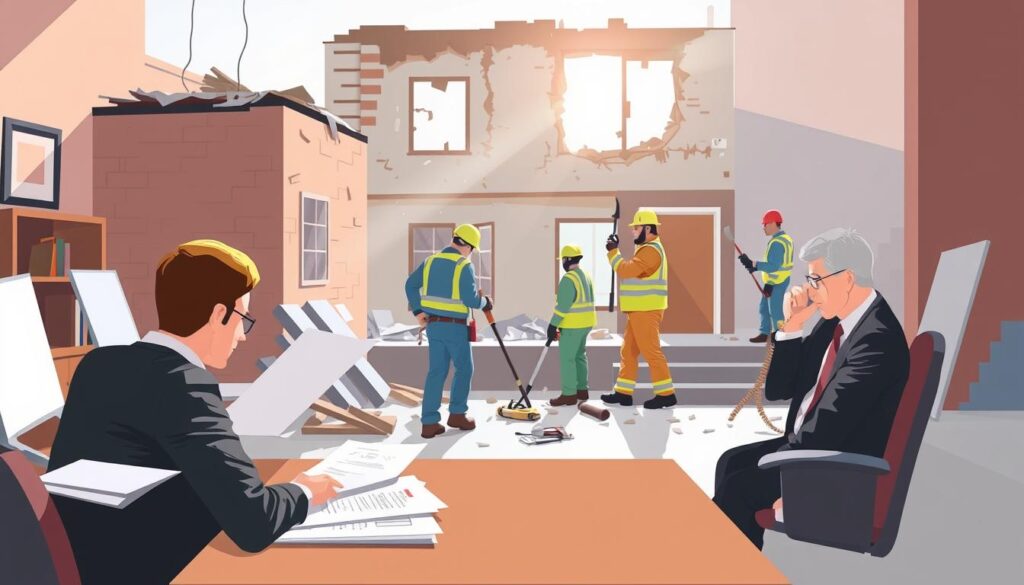
By identifying and documenting code compliance issues, restoration companies can further support homeowners in receiving the necessary coverage for their restoration projects. This advocacy role is crucial in ensuring that property owners are not left to navigate the complexities of insurance terminology and claims processes on their own.
The Insurance Claims Process for Restoration Work
When disaster strikes, navigating the insurance claims process is a critical step in restoring your property. This process involves several key steps that homeowners should understand to ensure a smooth experience.
Filing the Claim: First Steps After Damage
After experiencing damage, the first step is to file a claim with your insurance company. This involves notifying your insurer about the damage and providing initial documentation. The restoration company can assist in this process by providing the necessary documentation and estimates for the repair work.
The insurance adjuster will then be assigned to your case to assess the damage and determine the extent of the coverage.
Damage Assessment and Documentation
A crucial part of the claims process is the damage assessment and documentation. The restoration company will conduct a thorough assessment of the damage and provide a detailed estimate for the necessary restoration work. This documentation is critical in supporting your claim.

Approval and Settlement Process
Once the damage assessment and documentation are complete, the insurance adjuster will review the estimate to determine whether it aligns with your policy. At this point, you may need to negotiate the terms with the adjuster. Having a detailed and accurate estimate from the restoration company is invaluable in justifying the repairs and associated costs.
The settlement process typically involves structured payments, including advance payments, progress payments, and final settlements. Experienced restoration companies can expedite the approval process through professional documentation and established relationships with insurance adjusters.
Types of Restoration Services Covered by Insurance
Insurance policies typically cover various types of restoration services for property damage. Restoration companies work closely with insurance providers to ensure that property owners receive the necessary coverage for their restoration needs.
Water Damage Restoration
Water damage restoration services are often covered by insurance, especially when the damage is sudden and accidental, such as from a burst pipe. Restoration companies provide emergency services, including water extraction and drying, to prevent further damage. Prompt action is crucial to minimize the impact.
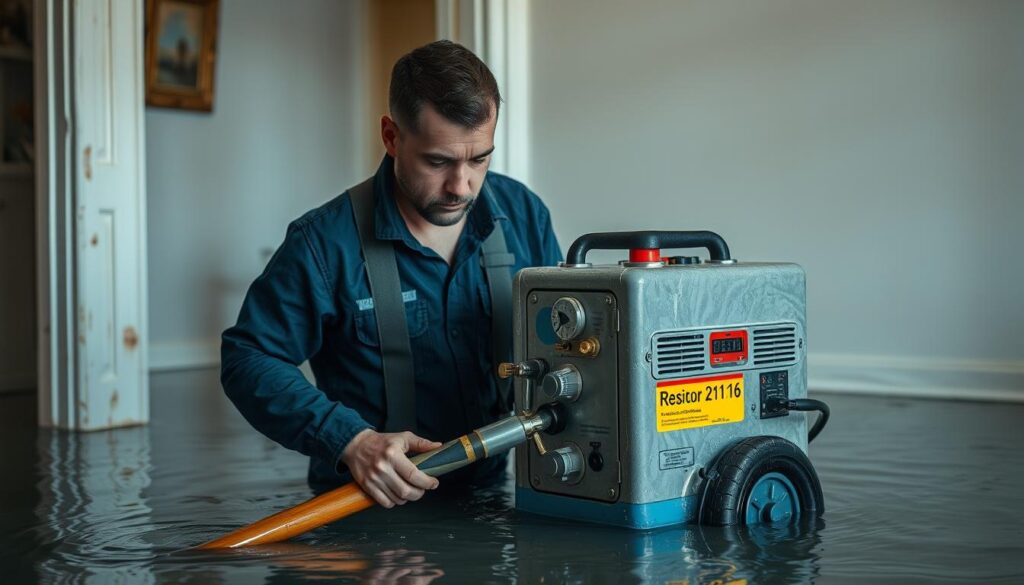
Fire and Smoke Remediation
Insurance typically covers fire damage restoration, including soot and smoke remediation. Restoration professionals assess the damage, clean, and restore the property to its pre-loss condition. This process involves specialized equipment and techniques to remove smoke odors and residues.
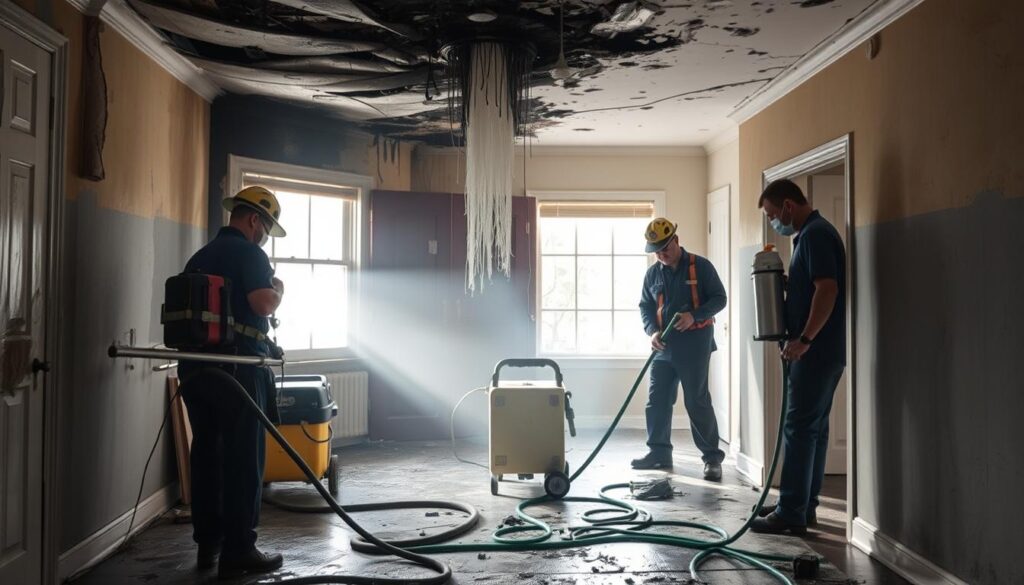
Mold Remediation
Mold remediation services are covered by insurance if the mold growth is a result of a covered event, such as water damage from a burst pipe. Restoration companies identify the source of the moisture, contain the affected area, and remove the mold, ensuring a safe environment.
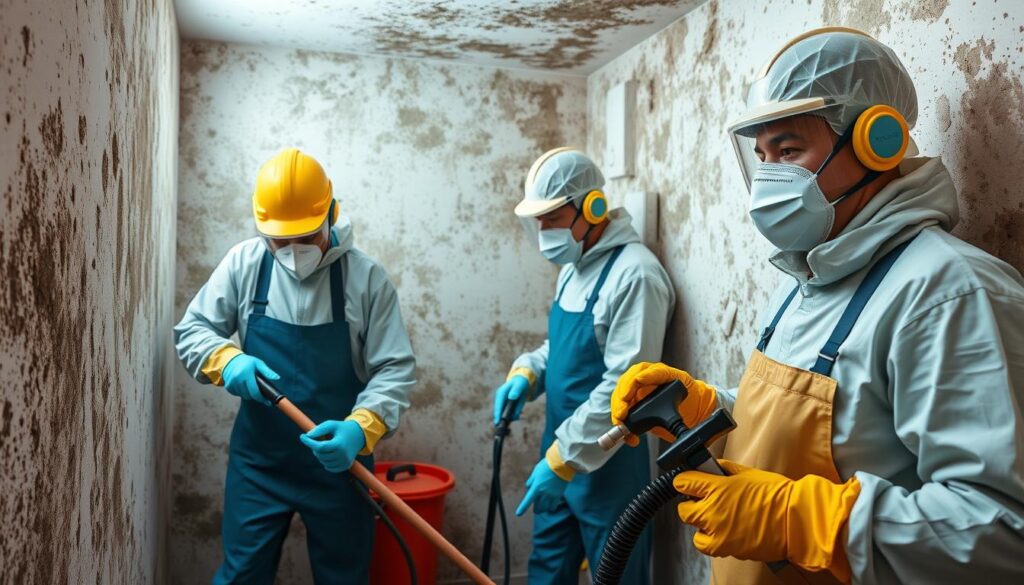
Storm and Disaster Recovery
Insurance policies often cover storm and disaster recovery services, including debris removal, structural repairs, and water intrusion mitigation. Restoration companies provide emergency response services to secure the property and prevent further damage, helping property owners return to normal as quickly as possible.
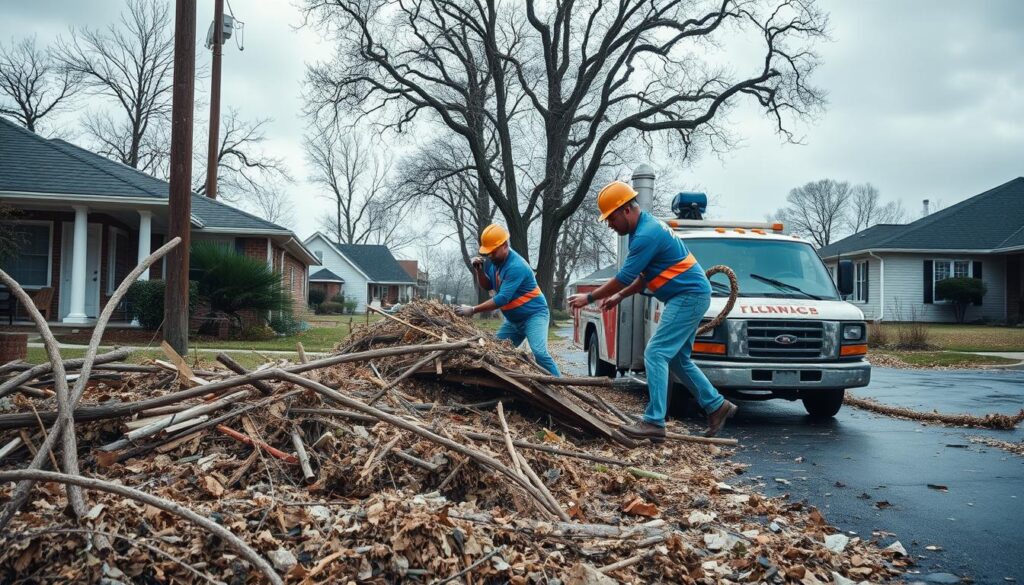
Coordination Between Restoration Professionals and Insurance Adjusters
The synergy between restoration professionals and insurance adjusters is key to navigating the intricacies of insurance claims. This collaboration is essential for ensuring that restoration work is done efficiently and effectively, with minimal disputes or issues.
Direct Communication Channels
Direct communication between restoration companies and insurance adjusters is vital for resolving issues promptly. Restoration professionals work closely with adjusters to address any cost discrepancies, providing detailed documentation to support their claims. This direct communication helps to prevent misunderstandings and ensures that the restoration process moves forward without unnecessary delays.
By maintaining open lines of communication, restoration companies can negotiate on behalf of the homeowner to resolve disputes efficiently. This proactive approach helps to mitigate potential issues that may arise during the restoration process.
Resolving Disputes and Discrepancies
Despite the best efforts of restoration professionals and insurance adjusters, disputes can still arise. Common discrepancies include issues with the scope of work, pricing, or coverage determinations. Experienced restoration companies address these issues through detailed documentation and industry standards.
For instance, a restoration company might use third-party documentation and industry pricing standards to support their position during disputes with insurance companies. As shown in the table below, the use of such documentation can help to resolve disputes more efficiently.
| Dispute Resolution Method | Success Rate | Average Resolution Time |
|---|---|---|
| Third-Party Documentation | 85% | 3 days |
| Industry Pricing Standards | 90% | 2 days |
| Negotiation | 80% | 4 days |
As the data indicates, using third-party documentation and industry pricing standards can significantly improve the success rate and reduce the resolution time for disputes.

Billing and Payment Procedures in Insurance Restoration
The billing and payment process for insurance restoration work can be complex, but knowing how it works can ease the burden on homeowners. Restoration companies often work closely with insurance providers to manage the billing process, ensuring that homeowners understand their financial responsibilities and the steps involved in the payment process.
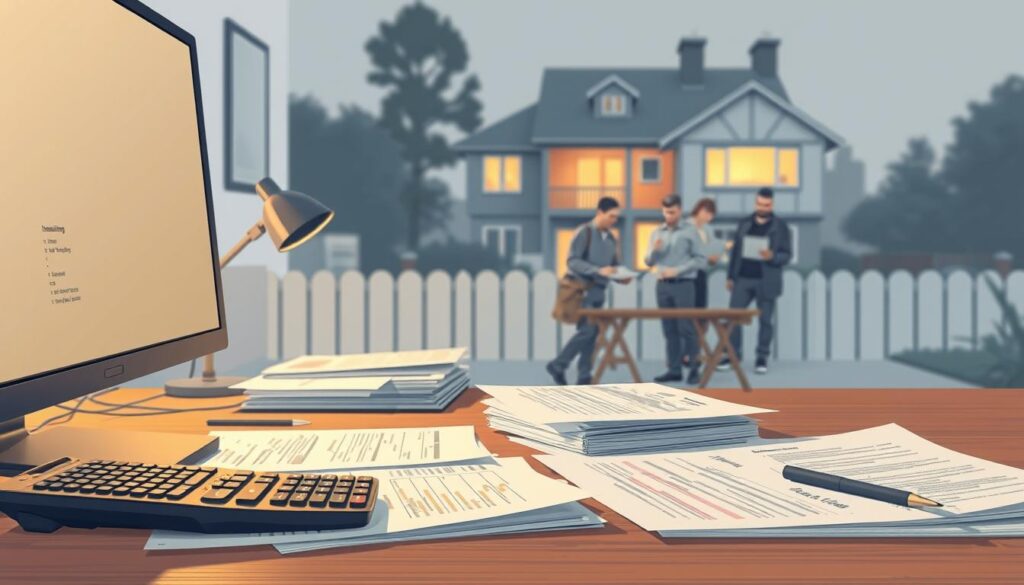
Direct Insurance Billing Benefits
One of the benefits of working with a restoration company is the ability to use direct insurance billing. This means that the restoration company will bill the insurance company directly for the restoration work done. This process simplifies the financial aspect for homeowners, as they do not have to pay out-of-pocket and wait for reimbursement. It also ensures that the insurance company is directly involved in the payment process, reducing the risk of disputes over the amount of work done.
Understanding Deductibles and Customer Responsibilities
While direct insurance billing simplifies the payment process, homeowners still have financial responsibilities, primarily their insurance deductible. Understanding the deductible amount and what it covers is crucial. Homeowners should review their insurance policy to know their rights and responsibilities regarding deductibles and the claims process.
Handling Supplemental Claims for Additional Damage
Sometimes, additional damage is discovered during the restoration process. In such cases, restoration companies help homeowners file a supplemental claim to cover the new damage. This involves documenting the additional damage and submitting it to the insurance company for approval. The restoration company will work with the homeowner and the insurance adjuster to ensure that the supplemental claim is processed efficiently, allowing for the necessary adjustments to the original claim amount.
Client Communication and Support Throughout the Process
At the heart of every successful restoration project is a commitment to transparent and regular communication. Restoration companies understand that navigating the restoration process can be stressful for property owners, which is why they prioritize keeping clients informed every step of the way.
Setting Clear Expectations
From the outset, restoration companies work to set clear expectations with their clients. This includes explaining the scope of the work, the timeline, and the costs involved. By doing so, companies like All Dry Services ensure that clients have a clear understanding of what to expect, reducing the likelihood of misunderstandings or surprises down the line. This transparency is crucial in building trust and ensuring a smooth restoration process.
Regular Updates and Transparency
Regular updates are a critical component of the communication strategy employed by restoration companies. Through various channels such as digital portals, photo/video updates, and in-person meetings, clients are kept abreast of the project’s progress. This level of communication not only provides reassurance but also allows clients to have peace of mind knowing that their property is being handled by professionals. Furthermore, transparency about any challenges or changes in the project’s scope helps to manage expectations and reduce anxiety.
By maintaining open lines of communication and providing regular updates, restoration companies can ensure that their clients feel supported throughout the restoration project. This commitment to transparency and client satisfaction is what sets companies like All Dry Services apart in the industry.
Conclusion: Ensuring a Smooth Restoration Experience
In conclusion, the partnership between restoration companies and insurance providers is crucial for property owners to navigate the complex process of restoration after a disaster.
Throughout this article, we’ve explored how restoration companies work with insurance to facilitate a smooth restoration process. From initial damage assessment to final payment, professional restoration companies play a vital role in guiding property owners through each step.
It’s essential for property owners to select a restoration company with experience in dealing with insurance claims. Such a company can effectively communicate with adjusters and ensure that all necessary work is included in the claim.
To ensure a positive outcome, property owners should be proactive in understanding their insurance policies before disasters occur and know their rights when working with both restoration companies and insurance providers.
By choosing the right restoration partner, property owners can transform a potentially stressful experience into a manageable process, ultimately returning their property to its pre-loss condition or better.
